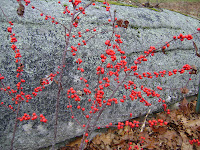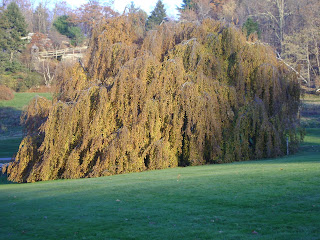Last week I headed back down to Longwood for the Chrysanthemum display and luckily hit it on one of the last days of Indian Summer.
Before I talk about mums, I wanted to compare some hardy woodies that are prevalent at Longwood with related plants growing on the Mountain.
First…deciduous conifers
We have two specimens of Dawn Redwood: Metasequioa glytostroboides. This tree was thought extinct until the 1940s, when it was discovered in China. Ours were planted in the early 60s.
They have intriguing fall color, sort of a rosy-bronze.
 |
| Metasequoia glyptostroboides Dawn Redwood |
 |
| Longwood Allee Taxodium distichum Bald Cypress |
 |
| "Knees" Taxodium distichum Bald Cypress |
“’Tis the season to be Holly”
Three Holly’s to talk about here at Mohonk.
Ilex verticillata or Winterberry, a native of eastern swamps just sings as the leaves fall and winter approaches.
 |
| Ilex verticillata Winterberry Holly |
 |
| Ilex verticillata 'Winter Gold' |
 |
Ilex cornuta Burford Holly |
 |
| Hydrangea quercifolia Oakleaf Hydrangea |
I’ve included a sampling of tender mums grown in the classic Japanese style. You really should go (next fall) to study in detail how these plants are grown and displayed. Some plants spend 18 months in cultivation. I wish I had the time…
Happy Turkey Day!
 |
| Single Stem Chrysanthemum Mound |
 |
| Single Stem Chrysanthemum Shield |
 |
| Standard Formal Incurve Chrysanthemum 'Hagoromo' |
 |
| Longwood East Conservatory Entrance Chrysanthemum arch |








